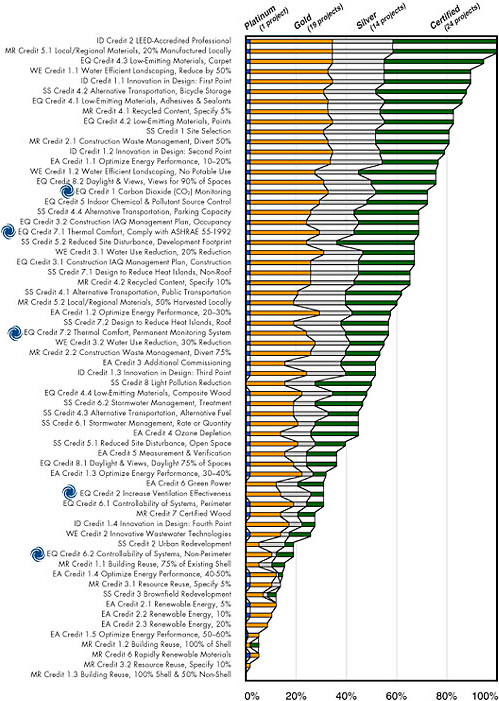The following table from the December 2003 issue of Environmental Building News shows the rate at which LEED Credits are being achieved. The Credits with the Titus logo designate HVAC specific credits. (Other credits, such as EA Credit 1, Optimize Energy Performance, are also applicable to HVAC, but are not highlighted as they are not HVAC specific.)

Source: Compiled from USGBC's project "Scorecards" by Rob Bolin, of Syska Hennessy Group, and Environmental Building News. Copyright © 2003 by BuildingGreen, Inc. All rights reserved; reprinted with permission.
buildinggreen.com/menus/leedList.cfm
.
The top 10 Credits achieved are:
- ID Credit 2 - LEED Accredited Professional
- MR Credit 5.1 - Regional Materials - 20%
- EQ Credit 4.3 - Low Emitting Materials, Carpet
- WE Credit 1.1 - Water Efficient Landscaping - 50%
- ID Credit 1.1 - Innovation in Design - 1st point
- SS Credit 4.2 - Alternative Transportation, Bicycle Storage
- EQ Credit 4.1 - Low Emitting Materials, Adhesives & Sealants
- MR Credit 4.1 - Recycled Content - 5%
- EQ Credit 4.2 - Low Emitting Materials, Paints
- SS Credit 1 - Site Selection
Noticeably missing from the top ten Credits achieved are the HVAC and thermal comfort related credits.
Of the HVAC specific credits marked in the chart above, EQ Credit 1, CO2 Monitoring, was achieved in 70% of the projects, EQ Credit 7.1, Thermal Comfort, Comply with ASHRAE 55, was achieved in 65% of the projects, EQ Credit 7.2, Thermal Comfort, Permanent Monitoring System was achieved in 55% of the projects, EQ Credit 2, Increase Ventilation Effectiveness, was only achieved in 30% of the projects, and EQ Credit 6.2, Controllability of Non-Perimeter Systems, was only achieved in 15% of the projects.
This shows that these five HVAC specific credits are underutilized and, if used, could help move the project to the next level of LEED Certification. The LEED Application Guide discusses these and other LEED Credits and provides information on products that can help you achieve LEED points.